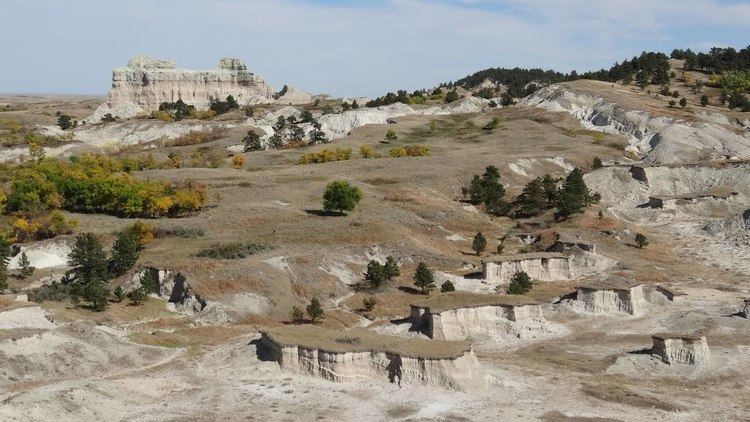Congressional district At-large Area 6,936 km² Population 1,262 (2013) Unemployment rate 2.8% (Apr 2015) | Founded 1909 Largest city Buffalo | |
 | ||
Website www.hardingcountysd.com Rivers Tie Creek, North Fork Grand River, Lone Tree Creek | ||
Harding County is a county located in the U.S. state of South Dakota. As of the 2010 census, the population was 1,255, making it the second-least populous county in South Dakota. Its county seat is Buffalo. The county was established in 1881 and named in honor of J.A. Harding, who had been Speaker of the House of the Dakota Territory. It was merged for a few years with Butte County, under that county's name, but became separate again in 1909.
Contents
- Map of Harding County SD USA
- Geography
- Major highways
- Adjacent counties
- National protected area
- 2000 census
- 2010 census
- Politics
- Towns
- Unincorporated communities
- References
Map of Harding County, SD, USA
Custer National Forest has its South Dakota portion in Harding County, and South Dakota State University operates the Antelope Range and Livestock Research Station about 14 miles (23 km) east of Buffalo.
Geography
According to the U.S. Census Bureau, the county has a total area of 2,678 square miles (6,940 km2), of which 2,671 square miles (6,920 km2) is land and 6.5 square miles (17 km2) (0.2%) is water. It is the fourth-largest county in South Dakota by area.
Major highways
Adjacent counties
National protected area
2000 census
As of the census of 2000, there were 1,353 people, 525 households, and 352 families residing in the county. The population density was 0.5 people per square mile (0.2/km²). There were 804 housing units at an average density of 0.3 per square mile (0.1/km²). The racial makeup of the county, as defined by the US Census was 97.63% White, 0.30% Black or African American, 0.74% Native American, 0.59% Asian, 0.37% from other races, and 0.37% from two or more races. 1.63% of the population were Hispanic or Latino of any race. 25.9% were of German, 24.3% Norwegian, 12.8% American, 7.1% Irish and 6.6% English ancestry according to Census 2000.
There were 525 households out of which 35.0% had children under the age of 18 living with them, 58.5% were married couples living together, 5.3% had a female householder with no husband present, and 32.8% were non-families. 31.0% of all households were made up of individuals and 14.5% had someone living alone who was 65 years of age or older. The average household size was 2.50 and the average family size was 3.19.
In the county, the population was spread out with 32.5% under the age of 18, 4.4% from 18 to 24, 24.8% from 25 to 44, 24.8% from 45 to 64, and 13.4% who were 65 years of age or older. The median age was 38 years. For every 100 females there were 104.7 males. For every 100 females age 18 and over, there were 102.0 males.
The median income for a household in the county was $25,000, and the median income for a family was $31,667. Males had a median income of $25,556 versus $16,375 for females. The per capita income for the county was $12,794. About 19.40% of families and 21.10% of the population were below the poverty line, including 22.80% of those under age 18 and 22.50% of those age 65 or over.
2010 census
As of the 2010 United States Census, there were 1,255 people, 539 households, and 348 families residing in the county. The population density was 0.5 inhabitants per square mile (0.19/km2). There were 731 housing units at an average density of 0.3 per square mile (0.12/km2). The racial makeup of the county was 95.9% white, 1.5% American Indian, 0.1% black or African American, 0.1% Asian, 0.7% from other races, and 1.7% from two or more races. Those of Hispanic or Latino origin made up 1.6% of the population. In terms of ancestry, 41.4% were Norwegian, 31.8% were German, 18.4% were Irish, 13.2% were English, and 2.6% were American.
Of the 539 households, 26.0% had children under the age of 18 living with them, 55.5% were married couples living together, 4.8% had a female householder with no husband present, 35.4% were non-families, and 32.1% of all households were made up of individuals. The average household size was 2.27 and the average family size was 2.87. The median age was 43.3 years.
The median income for a household in the county was $34,792 and the median income for a family was $46,111. Males had a median income of $38,929 versus $20,924 for females. The per capita income for the county was $22,004. About 13.7% of families and 16.1% of the population were below the poverty line, including 19.5% of those under age 18 and 16.9% of those age 65 or over.
Politics
Harding is a heavily Republican county in Presidential and Congressional elections. The last Democrat to win a majority in the county was Franklin D. Roosevelt in 1936. In 2008, Republican John McCain won 78% of the county's vote, while in 2012 Mitt Romney won 86% of the vote.
In the South Dakota Senate Harding is part of the 28th Senate district, which is held by Republican Betty Olson. In the State House Harding is part of district 28B, which is held by Republican J. Sam Marty.
